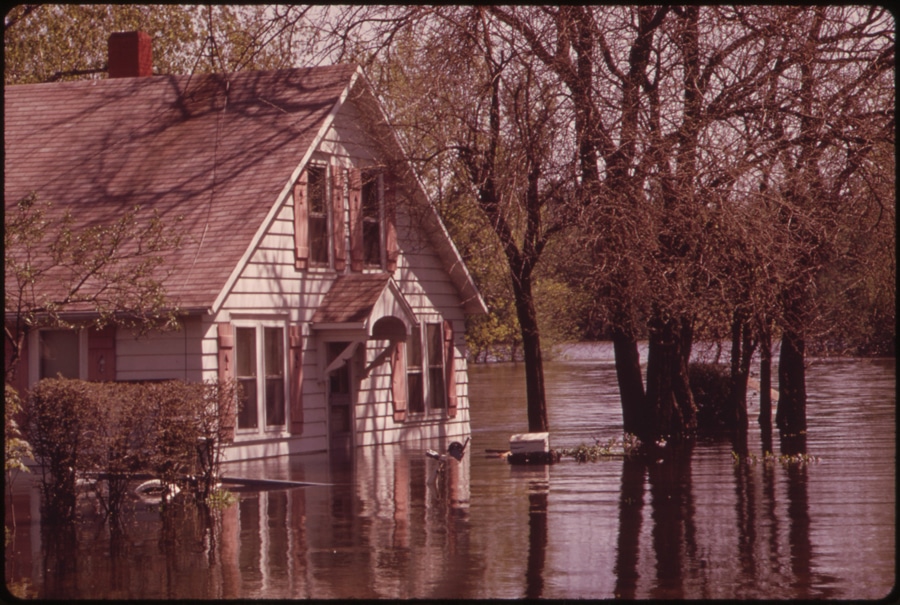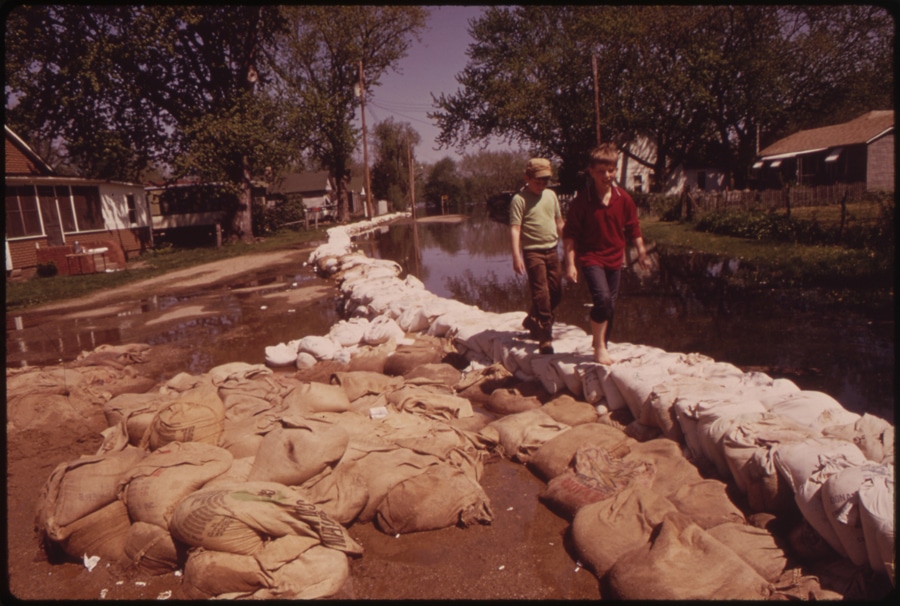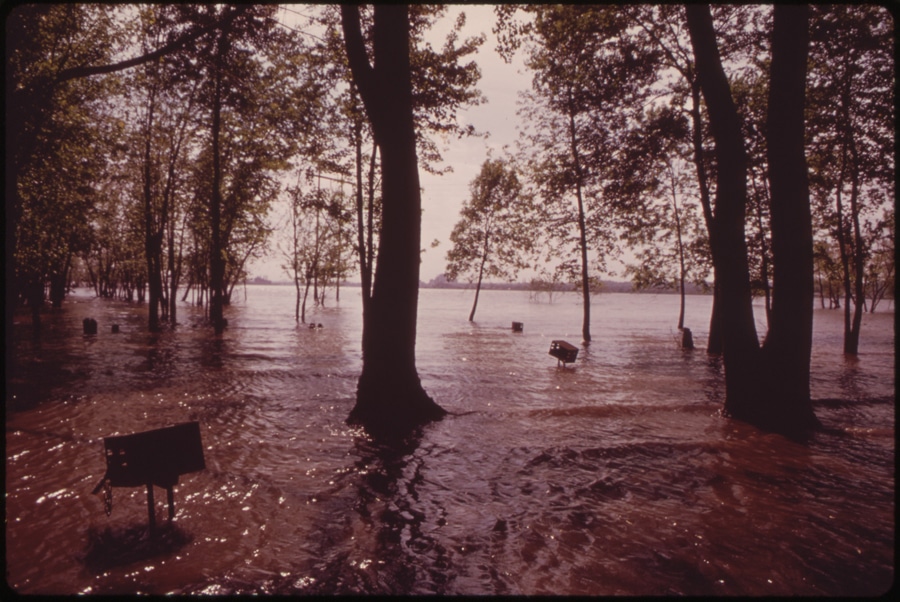Location: Peoria County, Illinois
Highlighted Element: 522.b. Buildings on the Repetitive Loss List (bRL)
Point of Contact: Andrew Braun, CFM, Planner III – Peoria County, IL
Peoria County is known as the Heart of Illinois. The County runs along the Illinois River, has a population of 182,495, and is 629 square miles (“About Us,” no date).
According to Andrew Braun, a planner for Peoria County, the county came to focus its efforts on acquiring repetitive loss properties due to consistent and repetitive flooding that has occurred in the region for at least the past 100 years. The eastern boundary of Peoria County lies along the Illinois River, which floods nearly every year and has flooded approximately 120 times in the last 100 years.

In addition, Peoria County has one of the highest counts of properties on the repetitive loss list in the state of Illinois. As a result, the county actively applies for funding to remove these properties any time they can. In the past, the county has received funding from the U.S. Department of Housing and Urban Development (HUD), the Illinois Department of Natural Resources Department of Water Resources, the Illinois Department of Transportation, and they are currently working to receive funding from the FEMA Hazard Mitigation Grant Program. Braun says that every time there is a Presidential disaster declaration the county applies for more funding. The county’s goal is to receive money to acquire the properties, demolish them and then convert the land to permanent open space in the floodplain areas.
At one point in time, Peoria County had 579 structures in the Illinois River floodplain. As a result of the county’s efforts, 125 of these properties have been acquired (10-15 relocated, the rest demolished) and about 50-75 homes have been elevated (paid for privately by the homeowner). In addition, at least one third of the structures existing in the floodplain in 1985 have been mitigated. Finally, the county currently has a program that will acquire another 20 properties this year on the Illinois River and an additional 20 homes in the Kickapoo Creek watershed.
These statistics are a testament to Peoria County’s success with respect to the acquisition of properties on the repetitive loss list and more generally, their efforts to enhance the resilience of their community. But these successes have not been realized without challenges. What follows is an overview of the challenges Peoria County encountered when attempting to buy-out floodplain properties, as well as the crucial factors that contributed their success and benefits reaped by this community.

Challenges
Time has been the biggest challenge associated with the buy-out process. Specifically, the length of time it takes to receive funding. Sometimes it can take over a year to get approval and funding to buy actual properties. Peoria County is able to overcome this challenge by being very open with the County residents. Braun says that he will send updates out even if he just received an email on how the buyout application is going. He also stresses the importance of empathizing with the property owners. Braun says that Peoria County will hold public meetings to talk about what has happened or is happening and why. This helps with maintaining the public’s interest, managing expectations, and avoiding having property owners rescind their offers to sell.
Additionally, Peoria County does not currently have a full-time floodplain manager. This is a challenge because buy-out programs can take a significant amount of time to orchestrate. Specifically, Braun estimates that when he is working on a buyout he expects it to be a 12-18 month process and that takes about 50% of his time with about 7-8 other people occasionally working on it (ex. Director, Assistant Director, Planners, Administrative, Finance, State Attorney's, etc.). He also estimates that there is about 40 hours total a week of administrative time on a given buyout program in the implementation phase but only about 5 hours per week during the maintenance phase.
Another notable challenge is that there are some maintenance costs associated with the acquisition of properties in the floodplain. This is because most acquisition grants require the county to maintain the properties after all structures have been demolished. There is also the staff cost of traveling to the sites to do inspections. To offset these costs, they partner with other townships and park districts and then sometimes turn some of the acquired properties over to them to manage. For example, a set of 20 properties was turned into a dog park by the park district. They also have pull-offs within these areas for people to look at the eagle population.
Finally, the buyout process itself is a challenge. There is a lot of information available about what needs to be done (program requirements) but not about how to do it or how it applies to your specific community. There are a lot of resources available to help and Braun’s biggest piece of advice is to find someone who has been through this before and who is willing to answer your questions a few times a week- he recommends reaching out to a CRS coordinator in a nearby community or to the ISO specialist who will be conducting your review. They may not be dealing with the same specific details but the overall process is likely the same.
Factors Contributing to Peoria County’s Success
One critical factor that has contributed to Peoria County’s success is that they have established a relationship with most of the community. The county approaches the buy-out process as trying to help homeowners and not trying to be the bad guys. This has been immensely beneficial as all properties have been, and will continue to be, acquired voluntarily. Following a flood event, Peoria County will assess damage and ask that the property owners contact the county. They will often hold a “flood open house” near the flooded area to answer questions and to inform residents of what the County is doing, the next steps and to provide a general timeline for the buyout and recovery process. The county also brings the state hazard mitigation officer and the state floodplain manager to these events so that they can introduce some of the other options that are available to the homeowners. County staff at the flood open houses also offer “voluntary interest forms” that homeowners can fill out. These forms essentially allow homeowners to state that they are willing to discuss selling their homes. Peoria County then puts together an application based on the number of forms they receive and submit for buyout funding.
According to Braun, citizen involvement has also been vital to the county’s work. Notably, it helps to have past examples from the community when trying to explain the buyout process. Peoria County has also had residents speak about their own experiences at their public meetings and they recommend finding someone in the community who has been through this and is willing to reach out to the community. Having multiple perspectives has been incredibly valuable.
Learn more about how your community can take credit for property acquisitions in the floodplain. Check out the Green Guide profile for Activity 520.
Another critical element that has contributed to Peoria County’s success is their ability to acquire grant funding. The county has been successful in receiving funding partly due to the county’s ability to buy out groups of homes and not just single properties. Often times when a flood occurs one household will be find it necessary to mitigate (i.e. elevate their home or sell). When neighboring property-owners see the benefit of this mitigation, they volunteer to take the same action. For example, many people are voluntarily elevating their homes after one person was forced to. Residents see the benefit of elevating their homes when the person with a mitigated property easily overcomes a flood event while they suffer damages. Additionally, since the lot sizes in Peoria County tend to be small, property-owners receive added benefits from elevating their homes as they can then have a garage under them. According to Braun, some homeowners are elevating just so they can have a garage on their property.
Finally, another factor that has contributed to Peoria County’s success is their membership to their state floodplain management association. The county works closely with the Illinois Association of State Floodplain Managers (IASFM), which helps them share information with and learn about best practices from other communities. For example, Peoria County made their elevation certificates available online after seeing what another Illinois community had done at an IASFM meeting. The county’s collaboration with IASFM has also helped them to identify when and where grant funding is available, this is especially critical for Peoria County because they do not have the dollars on hand to acquire properties on their own. Finally, CRS user groups, FEMA-hosted webinars, and the Association of State Floodplain Managers have also been valued resources that have helped the county to achieve success.

Benefits
While there will always be flood risk due to the location of Peoria County, through the community’s efforts to acquire properties on the repetitive loss list, they have lessened flood losses. One example of how these buy-outs have reduced flood losses occurred in 2013 when a severe flood hit Peoria County. This flood only impacted 60-70 properties. Braun estimates that if the same flood had occurred in 1985, over 200 properties would have been damaged.
Another benefit of the County’s efforts to acquire buildings on the repetitive loss list is that it has allowed their emergency responders to be more effective. For example, in 2015 Peoria County had a flood that would have been very damaging in the past but only impacted about 4 properties. The county emergency responders know that certain areas no longer have structures, or that they have been elevated and would not be impacted at the current flood depth, so there is less area for them to cover when responding after a flood event. Additionally, Braun notes that there would have been worse downstream flooding had the land from the 125 acquired properties not been converted to open space.
Finally, habitats for fish and wildlife, as well as recreation opportunities have all enhanced as a result of the County’s actions. There are an abundance of bird nests in the open space that have led to recreational opportunities such as bird watching. Additionally, some lots now have boat launches which also increases the accessibility to the river. Finally, the county has also created “pocket parks” and even restored acquired lands back to their natural habitat which is very aesthetically pleasing.
Best practices shared by this community:
- Be open, give frequent updates, and empathize with the property owners. Buyout programs take a long time and quality communication and outreach is key.
- Find local residents who have experienced the buyout process to speak to the community and who is willing to connect with other property owners.
Through element 522.b. Buildings on the Repetitive Loss List and other efforts for which the city can receive credit, Peoria County has reached a class 5 rating in the CRS. This has resulted in a 25% reduction in the cost of flood insurance for policyholders.